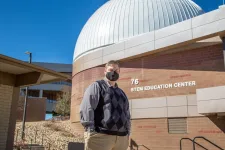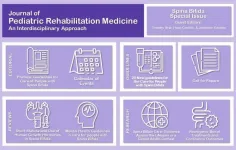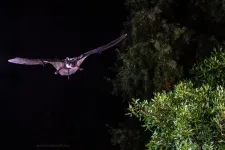(Press-News.org) Within the constellation Cygnus, an elderly star and its massive companion are having one last hurrah, flinging off mass at an incredible rate before they explode as supernovae and collapse into a black hole.
Now, researchers including recent Embry-Riddle Aeronautical University graduate Laura M. Lee have mapped the elderly star's orbit around its oversized and equally ancient partner. In a scientific first, they have also determined the dynamical mass of both stars that make up a binary system called Wolf-Rayet 133.
The team's findings, published Feb. 9, 2021 by Astrophysical Journal Letters, mark the first-ever visually observed orbit of a rare type of star called a Nitrogen-rich Wolf-Rayet (WN) star. The WN star in question is half of the starry dance duo in the WR 133 binary.
The WN star pirouettes around its partner star, an O9 supergiant, every 112.8 days - a relatively brief orbit, indicating that the two stars are close together, researchers reported. The WN star has 9.3 times more mass than our Sun, while the O9 supergiant is a whopping 22.6 times more massive, the team found.
Imagining the Early Universe
The research opens a new window to the distant past when stars and planets were first beginning to form.
Wolf-Rayet type stars, so named for the astronomers who discovered them in 1867, are massive stars near the end of their lives, said Lee's faculty mentor Dr. Noel Richardson, assistant professor of Physics and Astronomy at Embry-Riddle. They're very hot, a million times more luminous than the Sun, and stellar winds have stripped off their hydrogen envelopes. That has made it difficult to measure their mass - a vital step toward modeling the evolution of stars - until now.
Because the pair of stars in the WR 133 binary are tightly coupled, they've likely exchanged mass, Richardson noted. "In the early universe, we think most stars were very, very massive and they probably exploded early on," he said.
"When these types of binary stars are close enough, they can transfer mass to each other, possibly kicking up space dust, which is necessary for the formation of stars and planets. If they're not close enough to transfer mass, they're still whipping up a huge wind that shoots material into the cosmos, and that can also allow stars and planets to form. This is why we want to know more about this rare type of star."
Lee was still an undergraduate at Embry-Riddle when Richardson invited her to help solve an intriguing astronomy riddle, as part of her senior capstone project. Richardson had been analyzing data from the CHARA Array, a collection of six telescopes positioned across California's Mount Wilson. The array, operated by Georgia State University's Center for High Angular Resolution Astronomy, could pluck out celestial details smaller than the angular size of a dime in New York City from the telescopes near Los Angeles, California.
Lee's specific task was to make sense of about 100 spectra - barcode-like graphs that reveal how much light a star is giving off. To better understand WR 133's spectra, provided by Grant M. Hill of the Keck Observatory in Hawaii, Lee used computer code that allowed the team to measure how the two stars were moving. "These measurements are a necessary step because they tell us how the stars move back and forth from us, while the CHARA measurements told us how they move across the sky," Richardson explained. "The combination gives us the ability to see a three-dimensional orbit, which then tells us the masses."
At the time, Lee was laser-focused on earning her Embry-Riddle degree. "I didn't really realize how big of an impact we were making in this field," said Lee, a member of the Sigma Pi Sigma physics honors society who now holds an Astronomy degree with a Mathematics minor. "It was pretty exciting to be a part of the project, especially as an undergraduate student."
`A Blue Marble in Space'
At the Armagh Observatory & Planetarium in Northern Ireland, one of the many institutions involved in the project, Andreas A.C. Sander said the team's findings were somewhat surprising and will prompt researchers to rethink key assumptions. "The results are very interesting as they yield a lower mass than expected for such a star," Sander noted.
"While this might sound like a detail, it will change our perception of the Black Holes resulting from collapsing Wolf-Rayet stars, a crucial ingredient in the astrophysical context of gravitational wave events."
Gail Schaefer of the CHARA Array noted that Richardson's observations using the Georgia State University (GSU) telescopes on Mount Wilson - made possible through an open-access program at the facility - "will help improve our understanding of how binary interactions impact the evolution of these massive stars."
Astronomer Jason Aufdenberg of Embry-Riddle, who has also used the CHARA Array, said that "the kind of work Noel is doing, establishing orbits, is very important because they can get the masses of these things. Knowing about these very hot stars, how many there were and their luminosities is all part of understanding what happened in our universe after the Big Bang."
Now at the beginning of her career, Lee said she hopes to keep learning and being amazed by our universe. "We are on a blue marble floating in space," she said. "It's important to learn more about the complexities of the universe around us. Humans are born to learn. Any knowledge we can gain is a gift."
INFORMATION:
The research project included collaborators from many parts of the world and multiple institutions. In addition to Embry-Riddle, GSU's Chara Array, the Armagh Observatory and the Keck Observatory, the work involved Michigan State University, the University of Arizona, the University of Denver, the University of Exeter in the United Kingdom, the Institute of Astronomy in Belgium and the Institute of Planetology and Astrophysics in France.
The Astrophysical Journal Letters paper is entitled "The First Dynamical Mass Determination of a Nitrogen-rich Wolf-Rayet Visual and Spectroscopic Orbit." Journalists, please request the full paper if you cannot access it:
https://iopscience.iop.org/article/10.3847/2041-8213/abd722.
(DOI: 10.3847/2041-8213/abd722.)
A preprint version of the paper is online here:
https://arxiv.org/abs/2101.04232
About Embry-Riddle Aeronautical University
Reporters worldwide contact Embry-Riddle Aeronautical University for content experts in all aspects of aviation, aviation business, aerospace, engineering and STEM-related fields. Our faculty experts specialize in unmanned and autonomous systems, security and intelligence, air traffic and airport management, astronomy, human factors psychology, meteorology, spaceflight operations, urban air mobility and much more. Visit the Embry-Riddle Newsroom for story ideas.
Embry-Riddle educates 33,500+ students at its residential campuses in Daytona Beach, Florida and Prescott, Arizona, at approximately 125 Worldwide Campus locations and through online degree programs. In 2021, U.S. News & World Report named Embry-Riddle Worldwide the nation's No. 1 provider of online bachelor's degree programs.
While the World Health Organization (WHO) continues its mission to Wuhan investigating the origin and early transmission of SARS-CoV-2, a new study led by scientists from Duke-NUS Medical School, Singapore, and Chulalongkorn University, Thailand, shows that SARS-CoV-2-related coronaviruses (SC2r-CoVs) are circulating in animals as far away as Thailand. The study, published in Nature Communications today, reported that high levels of neutralising antibodies against the virus were present in both bats and pangolins found in the Southeast Asian country. The study further indicates that more SC2r-CoVs are likely to be discovered ...
Amsterdam, NL, February 9, 2021 - Globally, nearly 300,000 babies are born with neural tube defects including spina bifida (SB) each year. This openly available special issue of the Journal of Pediatric Rehabilitation Medicine (JPRM) provides 20 important evidence- and consensus-based updates to key sections of the 2018 "Guidelines for the Care of People with Spina Bifida" issued by the Spina Bifida Association (SBA). These reflect current recommendations for the care of patients with SB across the entire lifespan, from prenatal counseling to adult care.
As a result of research advancements and improved team-based patient care, approximately 80%-90% of children with SB now live to adulthood in the United ...
A study of women who were new mothers in the late 1970s found that those who were given longer, paid maternity leave lived healthier lives as they entered middle age.
While universal paid maternity leave is now available in many Western European nations, this has not always been the case. A new study by University of Georgia economist Meghan Skira looked at the health of Norwegian mothers before and after paid maternity leave became law in 1977. She found that the health benefits of leave continued for years after their children were born.
Skira, an associate professor in the Terry College of Business, worked with economist Aline Bütikofer of the Norwegian School of Economics and Julie Riise of the University of Bergen on the study. Their paper, "The Impact of Paid ...
A study led by researchers at the University of Minnesota Medical School found a way to detect the presence of ovarian cancer in patients using Pap test samples, normally used to detect cervical cancer. Currently, no early warning system exists for ovarian cancer, which in 2021, is estimated to kill more than 13,700 women, according to the American Cancer Society.
"It is known as a 'silent killer' since women with early stages of ovarian cancer have symptoms that can often be confused with other ailments. Women are typically diagnosed when the cancer has progressed so far that other organs are involved, requiring major surgery and chemotherapy," ...
Russian researchers from HSE University have studied a hypothesis regarding the capability of the visual system to automatically categorize objects (i.e., without requiring attention span). The results of a simple and beautiful experiment confirmed this assumption. The paper was published in the journal Scientific Reports. The study was supported by a Russian Science Foundation grant.
Humans receive a lot of information from the environment through their vision. Every day, we face a flow of varied visual stimuli. At the same time, information processing requires cognitive resources. Like a computer processor, the human brain has limited capacity in terms of the data it is able to process and save ...
Anaphylaxis is a systemic allergic reaction that can affect the skin, the gastrointestinal tract, the respiratory system and the cardiovascular system. The most severe form of anaphylaxis is anaphylactic shock, which features hypotension and can cause death. This reaction can have several causes, such as allergic reactions to food, medicines or insect venom.
The molecular mechanisms that cause the severity of these kinds of reactions is still unknown. In a study led by researchers of the University of Barcelona and IDIBAPS, researchers analyzed the mutation of a gen detected in a patient who suffered from recurrent anaphylactic shocks caused ...
Growing the right crop in the right place within an impaired watershed can achieve significant water quality improvements, according to Penn State researchers, who conducted a novel study in the drainage of a Susquehanna River tributary in an agricultural area in southeastern Pennsylvania.
The research may reveal a potential path for restoring the troubled Chesapeake Bay, said Patrick Drohan, associate professor of pedology in the College of Agricultural Sciences and one of the study's authors. The bay -- which long has been impaired in large part by nutrients and sediment washing off crop fields and getting into surface waters that feed it -- needs bold solutions, such as changing cropping systems, he suggested.
"Other than when wastewater treatment plants came into compliance ...
BROOKLYN, New York, Monday, February 8, 2021 -- A holy grail for orthopedic research is a method for not only creating artificial bone tissue that precisely matches the real thing, but does so in such microscopic detail that it includes tiny structures potentially important for stem cell differentiation, which is key to bone regeneration.
Researchers at the NYU Tandon School of Engineering and New York Stem Cell Foundation Research Institute (NYSF) have taken a major step by creating the exact replica of a bone using a system that pairs biothermal imaging with a heated "nano-chisel." In a study, "Cost and Time Effective Lithography of Reusable Millimeter Size Bone Tissue Replicas with Sub-15 nm Feature Size on a Biocompatible ...
A team of researchers from the Laboratory of Biophysics at NUST MISIS, Lomonosov Moscow State University and D. Mendeleev University of Chemical Technology of Russia has summarized metal-containing diagnostic agents for positron emission tomography (PET), magnetic resonance imaging (MRI), and single-photon emission computed tomography (SPECT) imaging of Alzheimer's disease (AD). According to the researchers, metal-containing radiopharmaceuticals are not only highly effective for detecting early markers of Alzheimer's disease, but also synchrotron-independent and ...
Bats are the only mammals that can actively fly. Some species travel over one hundred kilometres on their nocturnal excursions in search of food. Researchers at the Max Planck Institute of Animal Behavior in Radolfzell have now discovered that European free-tailed bats use uplifting winds for their ascents - a behaviour that was previously known only from birds. To do this, they tracked the bats using mini GPS loggers and then linked the flight data to weather data. The animals can thus gain altitude of well over 1,000 metres without expending much energy. The results ...






